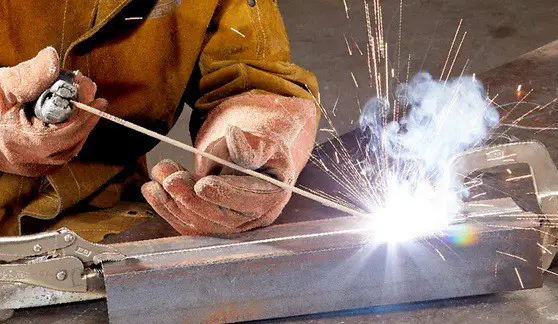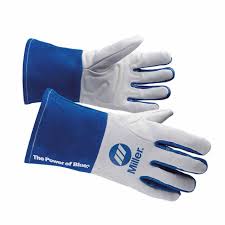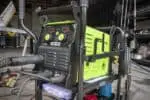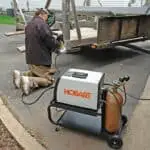There are many welders out there who touch the rod while they’re stick welding. It might give an impression that you too can touch the rod while the welding machine is on and running. But let us tell you, it’s a dangerous thing to do.
Although you can touch the rod while stick welding, there are certain conditions and precautions that must be followed carefully. For instance, your gloves should be completely dry. Without following such precautions, you can sustain serious burn injuries.
Bear in mind, a rod is always hot while the machine is on. An electrically hot rod is very, very hot. Touching it with bare hands can result in second-degree (even third-degree) burns.
Getting electric shocks is also a possibility. Nevertheless, at times, there’s no other way than to touch the electrode to stabilize the welding stick. This is where things get tricky.
If you touch the consumable rod at the wrong place (the endpoints) or you hold it for too long with damaged gloves, you’ll harm yourself. But, as we said, at times, there’s no other way to stabilize the welding stick than to touch the rod.
Naturally, you wouldn’t want to put yourself in harm’s way, but you wouldn’t want to ruin the weld either. If the electric arc isn’t stabilized and you do not know if the rod is hot enough to weld the metal in question, you’ll have to touch the welding rod anyways.
Hence, a truce is required: the truce includes wearing proper PPE, grounding the machine, and pinching the rod at the center.
If you want to know the in-depth details about should you and can you touch the rod while you’re stick welding without hurting yourself, then we have the answers, and we have explained them in the upcoming sections. Dive in for all details!
Can you Touch the Electrode While Stick Welding – Is it Safe?
Touching the rod when stick welding is possible. Whether or not it’s safe for you depends on whether or not you follow the proper precautions (to be discussed later on in this guide) to do so.
Many welders touch the rod when they’re using the stick welding method even after they’ve started the machine. Clearly, it is possible to touch the rod.
However, doing it needlessly isn’t recommended at all. It can be a serious workplace threat for novice welders.
A few scenarios where touching the rod becomes a necessity are as follows:
1.) If you don’t know whether the rod is already hot enough to carry out the work smoothly.
2.) If the stick is shaking and you’re losing control.
3.) If you aren’t able to pull the rod properly while welding.
In all the scenarios listed above, touching the electrode while you’re welding is the only way to carry out the work smoothly.
See also: Best Stick Welders for Beginners (Portable and Budget)
What Happens if You Touch a Welding Rod – Facts You Need to Know!
There are many misconceptions about touching a rod when stick welding. And incomplete knowledge is far more dangerous than no knowledge at all.
What can happen if you touch a welding rod while stick welding depends on how careful you were.
Let’s find out all the details!
Things that can happen if you don’t follow proper precautions:
1.) You will be at the risk of sustaining serious burn injuries.
2.) You might get electric shocks.
3.) You might damage the metal you were trying to weld.
4.) You might harm your fellow welders.
Things that can happen if you follow all the safety guidelines:
1.) You will eventually get better at stabilizing the rod while stick welding.
2.) You’ll take less and less time to finish the work.
3.) The finishing post-welding will be smooth.
Can You Hold The Metal While Stick Welding?
Holding the metal with your free hand while you’re stick welding is different from touching the rod, and safer too.
Most welders do it, and so can you. Holding the metal makes the most sense when the rod is new and long since that’s when it’s most unstable.
If you hold the metal in place, you’ll have better control after the arc is established. However, ensure you’re wearing proper welding glasses, welding helmets, and welding shields since sparks, fumes, and UV-rays are the major threats here.
Always remember, holding the metal is recommended only when the rod is long. Once the rod starts getting consumed, it will start getting shorter. Holding the metal when the rod is too short can be a safety hazard.
Top 2 Dangers of Touching The Rod While Stick Welding
#1. You’ll Burn Yourself
Sustaining burns is the most obvious risk of touching the rod while stick welding. If you think you’re absolutely safe while touching the rod if you’re wearing gloves, then we’d say, think again!
If the gloves are even slightly damaged, your skin will get exposed to immense heat.
Burns from an electrode aren’t minor either. You might have to go off work even for months if it’s a second or third-degree burn you sustained.
Besides, most welding gloves are designed to protect you from high temperatures for about 15 seconds. If you’ll hold the rod any longer than that, the chances that you’ll burn your hands badly are quite high.
See also: Can Sunscreen be Used to Prevent Burning from Welding?
#2. You Might Get an Electric Shock
The probability of shocks shouldn’t come across as a surprise whenever there’s electricity involved. Despite it’s DC that’s involved in welding (DC is less fatal than AC), it’s still no guarantee that you won’t be exposed to serious harm.
A welding rod can give you a primary shock as well as a secondary shock, and both types are unpleasant and dangerous.
Even a 50 V current can kill a person. The current in an open circuit arc welding can be as high as 200 V. Inside the welding arc, the voltage can be as high as 575 V.
You can imagine for yourself the harm that can happen if you touch an electrode while stick welding carelessly!
A primary electric shock might not kill, but the secondary one can!
5 Precautions to Follow When Touching the Rod While Stick Welding
#1. Wear Undamaged ASTM-approved Welding Gloves
Wearing any welding glove isn’t enough – only when the gloves you’re wearing are approved by the ASTM and tested by OSHA that they’re safe for welding.
Another very important thing to note is that no matter how high the gloves are rated, if they’re even slightly broken or punctured (even a minuscule crack), they’re a serious threat.
Only fully undamaged welding gloves will protect you from burns and shocks! So, the condition the gloves are in will be a deciding factor if you’re ever to touch a rod while stick welding.
#2. Touch the Rod Where the Current is the Least
If you’ll ever look closely, experienced welders will always touch the rod at the center to stabilize the welding stick. Touching the tip is a bad idea since that’s where the current is maximum.
Slightly pinching the rod (very briefly) in the center is enough to stabilize the rod while welding. Also, use your free hand to do so.
#3. Make Sure the PPE You’re Wearing is Dry
Perspiration is going to be your biggest enemy. If your gloves, your boots, your clothes, anything you’re wearing, in general,l is wet, your body will complete the circuit.
Water is a strong conductor of electricity. If the PPE you’re wearing is wet (no matter if it’s the result of sweat), the chances of getting an electric shock on touching the rod while stick welding will be very high.
#4. Ground the Machine at All Costs
Grounding the machine is an absolute necessity. That’s your biggest shield against getting an electric shock.
When the case is properly grounded, the fuse will immediately blow so that the power supply to the welding machine is immediately disconnected in case of an emergency.
#5. Wear the Right Welding Boots
It’s all about insulation. As long as the circuit for electricity passage won’t complete, you cannot get an electric shock.
That’s the purpose of wearing welding boots too. They will prevent the circuit from completing. An ASTM-rated welding boot will also have an insulated rubber sole since rubber is a very bad conductor of electricity.
So, pick the welding boots very wisely.
FAQs About Stick Welding
Can you stick weld in rain?
Yes, you can stick weld in rain, but it doesn’t mean you should. When something as minor as sweat can give you an electric shock if you touch the rod, imagine what could happen when it’s raining.
Yet, welders do weld despite it’s raining. If that’s the case with you too, follow the below-listed precautions.
1.) Stand on a rubber mat.
2.) Make sure the machine is covered and well-protected from the rain.
3.) Make sure you don’t touch the rod at all in such a scenario.
The focus should be to stay completely dry: you as well as your clothes and the welding machine.
How do you keep your hands stable when welding?
One of the few reasons that welders have to touch the rod while stick welding is that their hands are shaky. Most of the time, since a new rod is very long, it makes the entire stick shaky.
Whichever the case is, you can adopt the following techniques to stop your hands from shaking while stick welding.
1.) Pinch the rod briefly so that there’s enough tension to keep the rod stable.
2.) Pull the rod (or drag it) while welding instead of pushing it.
3.) Make sure there’s very little space between your arms and hands while you’re welding. The closer they are to your body, the better will be your control.
4.) If the metal block you’re welding is big enough, hold it down with the help of your free hand. It will reduce the shaking.
Ensure that your grip on the torch is very strong and comfortable before you start welding.
Concluding Thoughts:
Stick welding comes with the risks of sustaining burns and getting electric shocks. Things can get trickier if you touch the rod.
Despite it being a risky business, touching the rod while stick welding is possible. It’s, in fact, a necessity at times when the rod is shaking or your hands aren’t stable.
In a nutshell, you have to make sure that you are fully insulated while welding. That’s the only way to prevent getting electrocuted. As for the risk of burning, only ASTM-approved PPE can protect you.








